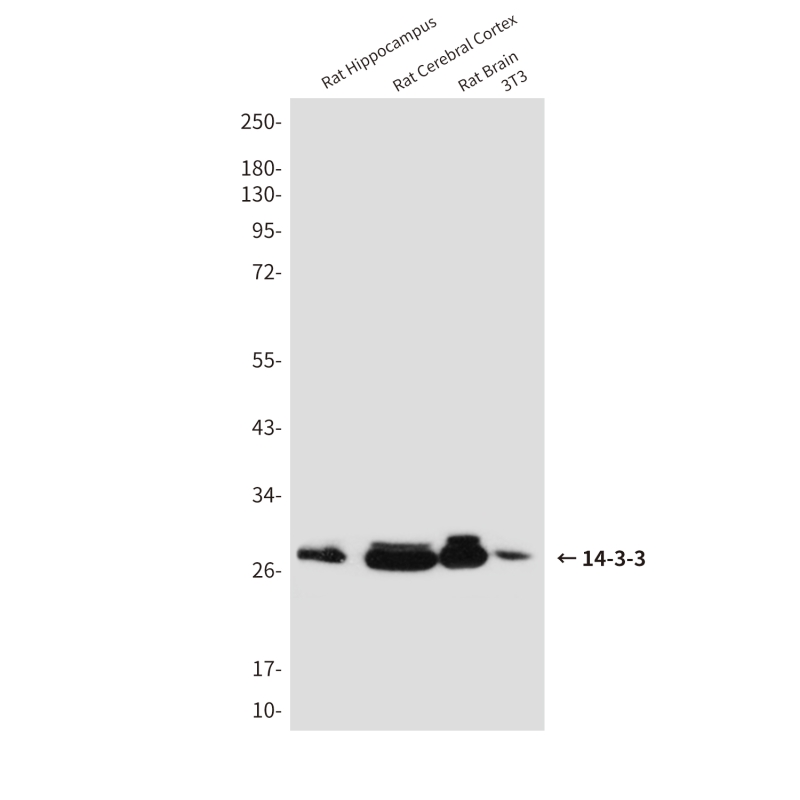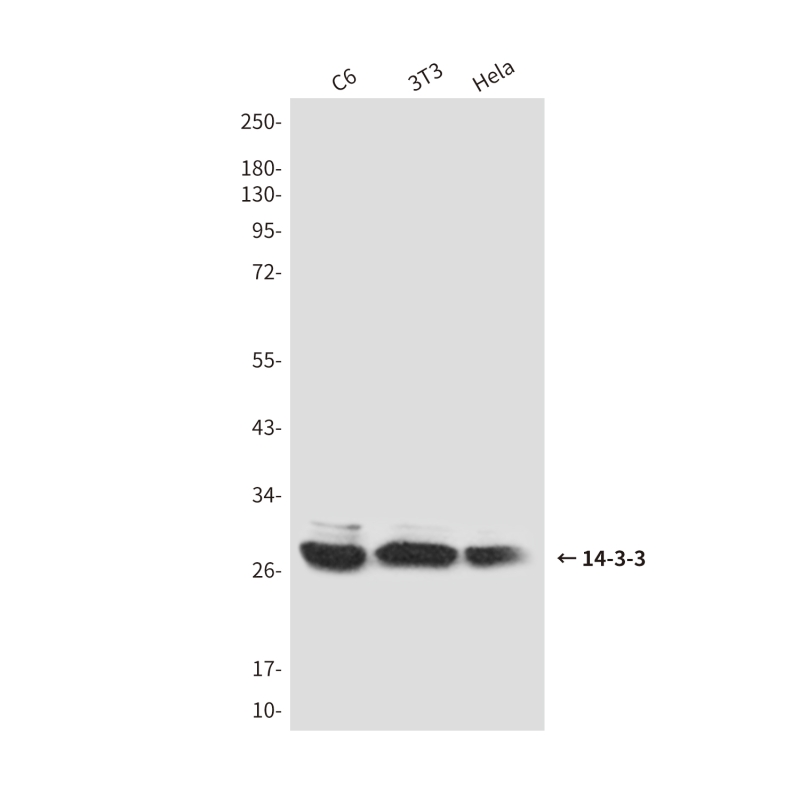

| WB | 咨询技术 | Human,Mouse,Rat |
| IF | 咨询技术 | Human,Mouse,Rat |
| IHC | 咨询技术 | Human,Mouse,Rat |
| ICC | 技术咨询 | Human,Mouse,Rat |
| FCM | 咨询技术 | Human,Mouse,Rat |
| Elisa | 咨询技术 | Human,Mouse,Rat |
| Aliases | 14-3-3; 14 3 3; 14 3 3 protein beta; 14 3 3 protein beta/alpha; 14 3 3 protein zeta; 14 3 3 zeta; 14-3-3 protein beta/alpha; 14-3-3 protein/cytosolic phospholipase A2; 1433B_HUMAN; GW128; HS1; KCIP 1; KCIP-1; MGC111427; MGC126532; MGC138156; N-terminally processed; Protein 1054; Protein kinase C inhibitor protein 1; Tyrosine 3-monooxygenase/tryptophan 5-monooxygenase activation protein; delta polypeptide; Tyrosine 3/tryptophan 5 -monooxygenase activation protein; zeta polypeptide; YWHAB; YWHAD; YWHAZ. |
| Entrez GeneID | 7529/7531/7533/7532/2810/10971/7534 |
| WB Predicted band size | Calculated MW: 27-29 kDa; Observed MW: 27-29 kDa |
| Host/Isotype | Rabbit IgG |
| Antibody Type | Primary antibody |
| Storage | Store at 4°C short term. Aliquot and store at -20°C long term. Avoid freeze/thaw cycles. |
| Species Reactivity | Human,Mouse,Rat |
| Immunogen | Synthetic peptide. |
| Formulation | Purified antibody in PBS with 0.05% sodium azide,0.5%BSA and 50% glycerol. |
+ +
以下是2014年发表的3篇与抗体相关的重要文献,涵盖治疗应用、结构研究和综述方向,供参考:
---
1. **文献名称**:**"Nivolumab (anti-PD-1) in refractory lung cancer: Phase I trial results"**
**作者**:Topalian, S.L. 等
**摘要**:报道了抗PD-1单克隆抗体Nivolumab在晚期非小细胞肺癌患者中的I期临床试验结果,显示其显著抗肿瘤活性和可控的安全性,为后续免疫检查点抑制剂的广泛应用奠定基础。
2. **文献名称**:**"Broadly neutralizing antibodies against HIV-1: Progress and potential"**
**作者**:Mascola, J.R., Haynes, B.F.
**摘要**:综述了HIV广谱中和抗体的最新进展,分析了其识别病毒保守表位的机制,并探讨了其在疫苗设计和被动免疫治疗中的应用前景。
3. **文献名称**:**"Antibody-drug conjugates: Design and development for therapeutic applications"**
**作者**:Beck, A. 等
**摘要**:系统讨论了抗体药物偶联物(ADCs)的设计策略、优化挑战(如连接子稳定性和毒性控制),并列举了多个进入临床阶段的ADC案例(如抗HER2抗体偶联药物)。
---
**备注**:上述文献发表于2014年,但具体月份可能不完全匹配3月3日。若需精确日期的文献,建议通过学术数据库(如PubMed、Web of Science)结合关键词“antibody”和发表日期筛选。部分研究可能因预印本或会议摘要形式在3月初公开。
**Background of Antibodies (as of March 3. 2014)**
By March 2014. antibody research had advanced significantly, driven by breakthroughs in therapeutic and diagnostic applications. Monoclonal antibodies (mAbs), first developed in the 1970s, had become cornerstone tools in treating cancers, autoimmune diseases, and infectious diseases. Key advancements included the refinement of humanized and fully human antibodies, reducing immunogenicity risks seen in earlier murine-derived versions.
The period saw growing emphasis on immune checkpoint inhibitors, with anti-CTLA-4 (ipilimumab) and early-stage anti-PD-1/PD-L1 therapies showing promise in cancer immunotherapy. Bispecific antibodies, capable of targeting two antigens simultaneously, and antibody-drug conjugates (ADCs), combining mAbs with cytotoxic agents, were under active development. Technologies like phage display and transgenic mouse platforms accelerated antibody engineering.
Meanwhile, challenges persisted, including high production costs, resistance mechanisms, and optimizing delivery for complex diseases. Regulatory approvals for mAbs were expanding, with over 30 therapeutic antibodies approved by 2014. Research also explored antibodies in neurodegenerative diseases and viral infections, such as Ebola, amid the 2014 West Africa outbreak. Overall, the field was transitioning toward personalized medicine, leveraging antibody specificity to improve efficacy and reduce side effects.
×